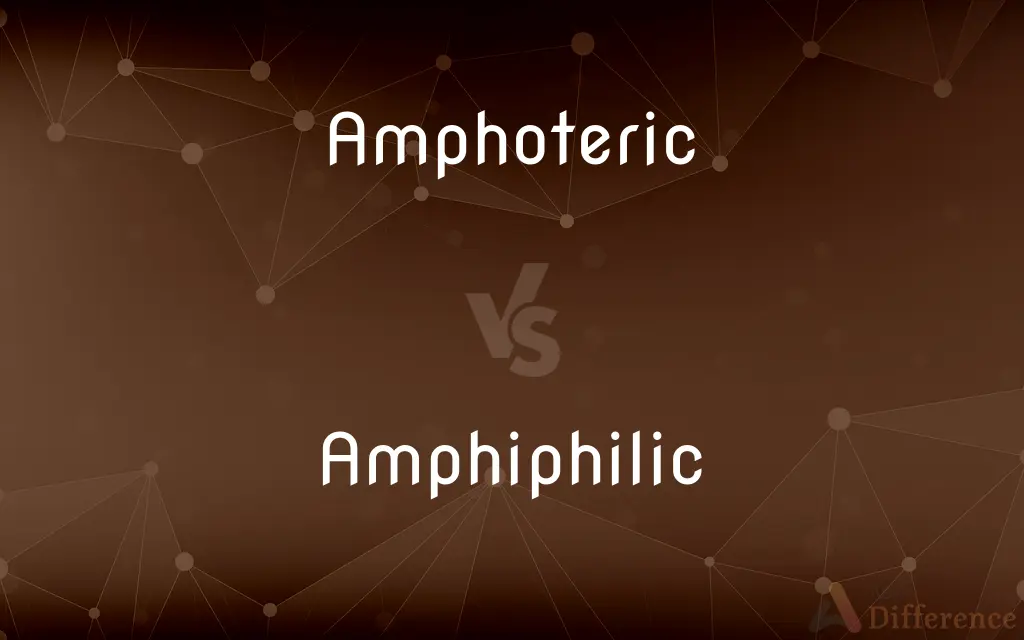Amphoteric vs. Amphiphilic — What's the Difference?
By Maham Liaqat & Urooj Arif — Updated on April 5, 2024
Amphoteric substances can react as either acids or bases, showing chemical versatility; amphiphilic molecules have both hydrophilic and hydrophobic parts, crucial for forming cellular structures and emulsions.

Difference Between Amphoteric and Amphiphilic
Table of Contents
ADVERTISEMENT
Key Differences
Amphoteric substances, by definition, have the ability to react as both acids and bases depending on their environment. This duality allows them to participate in a wide range of chemical reactions, making them versatile components in many biological and industrial processes. On the other hand, amphiphilic molecules are characterized by their dual affinity: a hydrophilic (water-attracting) part and a hydrophobic (water-repelling) part. This unique structure makes them essential in forming cell membranes, micelles, and emulsions, as they can interact with both water and lipid substances.
While the amphoteric property is primarily concerned with a substance's chemical reactivity and its ability to donate or accept protons, the amphiphilic nature focuses on physical interactions and the ability to interface between aqueous and non-aqueous environments. For example, water (H₂O) can act as an amphoteric substance, reacting as an acid in some reactions and as a base in others. Conversely, soap molecules, which contain both polar and non-polar regions, are amphiphilic, allowing them to dissolve oils in water.
The concept of amphotericity is crucial in understanding acid-base chemistry and is often discussed in the context of pH, buffer solutions, and chemical equilibrium. Amphiphilicity, however, is vital in understanding biological systems, detergency, and the formation of various nanostructures and delivery systems in pharmaceuticals. These properties allow amphiphilic molecules to form structures like liposomes, which are used for drug delivery mechanisms.
Despite these differences, both amphoteric and amphiphilic substances play crucial roles in biological and chemical systems. Amphoteric substances contribute to the maintenance of pH balance in biological systems and act as intermediates in many industrial chemical reactions. Meanwhile, amphiphilic molecules are fundamental in the formation of biological membranes and are widely used in food, cosmetics, and pharmaceutical industries to create emulsions and encapsulate active ingredients.
Both amphoteric and amphiphilic substances highlight the complexity of chemical interactions and the importance of these properties in a wide range of scientific and technological fields. While their functionalities and implications differ, they underscore the diversity and interdependence of chemical and physical behaviors in substances.
ADVERTISEMENT
Comparison Chart
Definition
Substances that can act as both acids and bases.
Molecules with both hydrophilic and hydrophobic parts.
Key Property
Chemical reactivity (ability to donate or accept protons).
Physical interactions (affinity for both water and lipids).
Importance
PH balance, buffer solutions, chemical equilibrium.
Formation of cell membranes, micelles, emulsions.
Examples
Water (H₂O), aluminum hydroxide (Al(OH)₃).
Soap molecules, phospholipids.
Application
Acid-base chemistry, biological systems maintenance.
Biological systems, detergency, pharmaceuticals.
Compare with Definitions
Amphoteric
Able to react as both an acid and a base.
Water acts as an amphoteric substance in some chemical reactions.
Amphiphilic
Essential in forming cellular structures.
Phospholipids are amphiphilic, forming the basic structure of cell membranes.
Amphoteric
Important in acid-base chemistry.
The amphoteric properties of bicarbonate make it a versatile component in many reactions.
Amphiphilic
Fundamental in nanotechnology and materials science.
Amphiphilic copolymers self-assemble into nanoscopic structures for various applications.
Amphoteric
Plays a key role in maintaining pH balance.
Amphoteric compounds are essential in biological buffer systems.
Amphiphilic
Used in creating emulsions in food and cosmetics.
Amphiphilic substances stabilize mixtures of oil and water in mayonnaise.
Amphoteric
Found in both inorganic and organic compounds.
Amino acids are amphoteric, containing both acidic and basic groups.
Amphiphilic
Molecules with both water-loving and water-hating parts.
Detergents are amphiphilic, enabling them to clean oily substances with water.
Amphoteric
Substances with dual chemical reactivity.
Aluminum hydroxide is used in antacids due to its amphoteric nature.
Amphiphilic
Plays a crucial role in drug delivery systems.
Amphiphilic polymers can encapsulate drugs for targeted delivery.
Amphoteric
Having the characteristics of an acid and a base and capable of reacting chemically either as an acid or a base.
Amphiphilic
Of or relating to a molecule having a polar, water-soluble group attached to a nonpolar, water-insoluble hydrocarbon chain.
Amphoteric
(chemistry) Having the characteristics of both an acid and a base, and capable of reacting as either; amphiprotic.
Amphiphilic
Being a detergent: having both hydrophilic and hydrophobic (or lipophilic) groups.
Amphoteric
Partly one and partly the other; neither acid nor alkaline; neutral.
Amphiphilic
Having one surface consisting of hydrophilic amino acids and the opposite surface consisting of hydrophobic (or lipophilic) ones.
Amphoteric
Relating to or containing an alkali; having a pH greater than 7;
Alkaline soils derived from chalk or limestone
Common Curiosities
Why are amphiphilic substances important in pharmaceuticals?
They can form structures like micelles and liposomes that encapsulate drugs, improving their delivery and effectiveness in the body.
What makes a substance amphoteric?
A substance is amphoteric if it can react as both an acid and a base, depending on its chemical environment.
How do amphiphilic molecules function in cell membranes?
Amphiphilic molecules, such as phospholipids, form bilayers that create a selective barrier around cells, allowing only specific substances to pass through.
How do amphoteric substances contribute to industrial processes?
They are used in a variety of processes, including as catalysts in chemical reactions, in wastewater treatment, and in manufacturing products like glass and ceramics.
What makes amphiphilic substances essential in nanotechnology?
Their ability to self-assemble into nanostructures is useful for creating materials with specific properties for electronics, drug delivery, and more.
What role do amphiphilic molecules play in detergency?
Their dual affinity allows them to emulsify oils and fats in water, effectively cleaning surfaces and fabrics by removing grease.
Can an amphoteric substance be amphiphilic?
While amphoteric refers to chemical reactivity and amphiphilic to physical structure, some molecules can exhibit both properties, but they are distinct characteristics.
Can amphoteric substances neutralize acids and bases?
Yes, because they can act as both acids and bases, amphoteric substances can neutralize excess acids or bases, maintaining pH balance.
Are all amphiphilic molecules used in food?
Not all, but many amphiphilic substances are used as emulsifiers to stabilize food mixtures, improving texture and shelf-life.
How are amphoteric and amphiphilic substances identified?
Through chemical tests that reveal their reactivity (amphoteric) and through physical observations of their interactions with water and oils (amphiphilic).
Share Your Discovery

Previous Comparison
Cove vs. Cape
Next Comparison
Sneaker vs. TakkieAuthor Spotlight
Written by
Maham LiaqatCo-written by
Urooj ArifUrooj is a skilled content writer at Ask Difference, known for her exceptional ability to simplify complex topics into engaging and informative content. With a passion for research and a flair for clear, concise writing, she consistently delivers articles that resonate with our diverse audience.














































